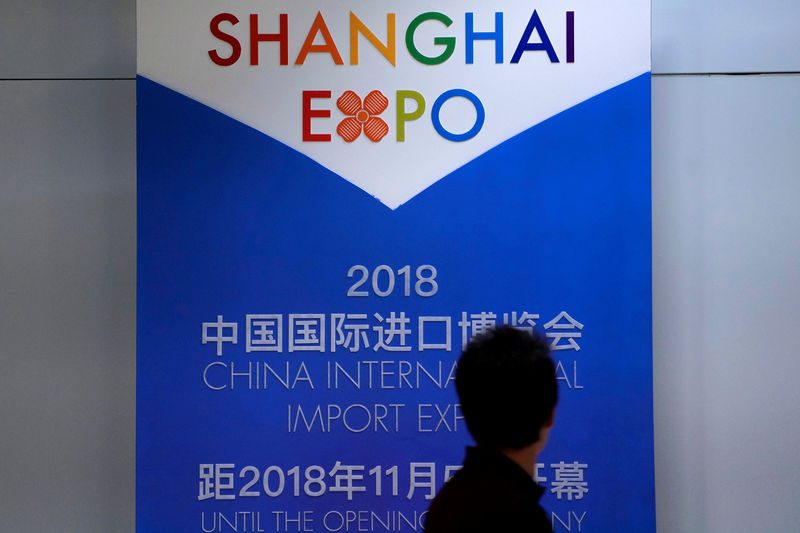 © Reuters. FILE PHOTO: A man walks past a countdown board of the China International Import Expo in Shanghai
© Reuters. FILE PHOTO: A man walks past a countdown board of the China International Import Expo in ShanghaiBy Michael Martina and David Lawder
BEIJING/WASHINGTON (Reuters) – With U.S. President Donald Trump gearing up to impose tariffs on $200 billion in Chinese goods and Beijing certain to retaliate against any measures, the world’s two biggest economies are locked in an escalating trade war, with no resolution in sight.
The United States is negotiating with Canada this week to try and finalize a deal to modernize the North American Free Trade Agreement, an outcome some in the White House say will allow Washington to turn up the heat on Beijing.
“The hope is that this (NAFTA) puts a lot of pressure on the Chinas of the world to help us negotiate better reciprocal trade deals,” Kevin Hassett, chair of the White House Council of Economic Advisers, told Reuters.
The world’s two largest economies have already applied tariffs to $50 billion of each other’s goods. Talks aimed at easing tensions ended last month without major breakthroughs, and Washington appears emboldened by a sell-off in Chinese markets and a weakening economy.
China is planning two choreographed celebrations of free trade – a major import fair in November and the 40th anniversary in late December of its move toward market reforms. However, Chinese government advisors are tamping down expectations either occasion will yield measures that could defuse tensions.
“China seems unable or unwilling to announce major liberalizations that could be termed ‘confidence building measures’ or ‘down payments’ on expected near-term reforms,” Craig Allen, president of the Washington-based U.S.-China Business Council, said in a letter to members over the weekend.
“We know that the President has received reports that the Chinese economy is struggling – reports that we believe are overstated – and thus he may believe that additional pressure might be effective in the short-term,” Allen said.
Washington is demanding Beijing improve market access and intellectual property protections for U.S. companies, cut industrial subsidies and slash a $375 billion trade gap.
The Trump administration is ready to move ahead with a next round of tariffs after a public comment period ends at midnight in Washington on Thursday, but the timing is uncertain, people familiar with the administration’s plans told Reuters.
The new duties will start to hit consumer products directly, including furniture, lighting products, tires, bicycles and car seats for babies.
Trump said he was not prepared to make a deal with China “that they’d like to make.”
“We’ll continue to talk to China,” he said at the White House on Wednesday.
“But right now we just can’t make that deal. In the meantime, we’re taking in billions of dollars of taxes coming in from China, with the potential of billions and billions of dollars more taxes coming in.”
Given the smaller amount of goods China imports from the United States on which it could slap duties, Beijing has vowed to hit back with unspecified “qualitative” and “quantitative” measures, actions perceived within the U.S. business community as likely to be increased customs and regulatory scrutiny.
Beijing appears to be bracing for a long fight.
Official Chinese media is asserting that Trump’s trade war is aimed at containing China’s rise, a perception solidifying Beijing’s resolve not to buckle under U.S. demands.
In light of such a U.S. agenda, China should “maintain strategic determination” and “take care of our own matters”, Long Guoqiang, vice president of the State Council’s Development Research Center, wrote in the People’s Daily.
“The Soviet Union was pulled into an arms race in the Cold War. Japan’s economy became a bubble in a trade war. These profound lessons are close at hand,” Long said.
While U.S. businesses in China do not yet appear to face widespread retaliation, some company officials have told Reuters they are bracing for blowback. Some are shifting supply chains to avoid tariffs.
WAITING GAME?
Wu Baiyi, Director of the Institute of American Studies at the state-run China Academy of Social Sciences (CASS), downplayed any impact of a new NAFTA deal on U.S.-China negotiations, saying Trump wants to push structural reform on China, not simply divert the flow of goods in bilateral trade.
“We have the patience to wait and we also have the flexibility to open talks any time.”
He said November’s import fair, one of President Xi Jinping’s key diplomatic events of the year, had long been planned to coincide with his “Belt and Road” global infrastructure plan, and to help transition China’s economy more toward domestic consumption.
Instead of any grand gestures that would placate Washington but present domestic challenges for quick implementation, Wu said he expects Xi to reaffirm “that he has no intention to reverse” on China’s path of reform and opening.
Trump faces potentially difficult mid-term elections in November as his Republican party fights to retain control of Congress. Some in Beijing appear to be hoping damage to his stature at home, including an ongoing investigation into Russian election meddling, could undermine his China agenda.
“Free trade will suffer a great setback, but it may be temporary,” Yu Yongding, a commissioner and senior researcher at CASS, told Reuters. “Who knows for how long Mr. Trump will still be in the Oval Office?”
But U.S. analysts cautioned it would be a mistake to assume Democratic Party gains in November’s congressional elections would change Trump’s calculus on China, given widespread business support for Trump’s goals of protecting American intellectual property and shifting China’s economy onto a more market-driven path.
“I think the president has reasonable political support among the electorate and his own base for action against China,” said Scott Miller, a trade scholar at the Center for Strategic and International Studies in Washington.
“Soybean farmers are not real happy about the tariffs but recognize the need to do something about China.”
Source: Investing.com



























